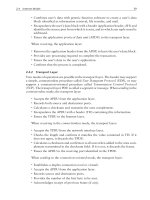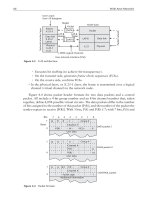A guide to oral communication in veterinary medicine
Bạn đang xem bản rút gọn của tài liệu. Xem và tải ngay bản đầy đủ của tài liệu tại đây (6.5 MB, 472 trang )
A GUIDE TO
ORAL COMMUNICATION
IN VETERINARY MEDICINE
www.pdfgrip.com
www.pdfgrip.com
A GUIDE TO ORAL
COMMUNICATION
IN VETERINARY
MEDICINE
Ryane E. Englar, DVM, DABVP (Canine and Feline Practice)
Associate Professor
University of Arizona College of Veterinary Medicine
Oro Valley, AZ
www.pdfgrip.com
First published 2020
Copyright © Ryane E. Englar 2020
All rights reserved. No part of this publication may be reproduced, stored in a retrieval
system, or transmitted, in any form or by any means, electronic, mechanical, photocopying,
recording or otherwise, without prior permission of the copyright holder.
Published by
5M Publishing Ltd,
Benchmark House,
8 Smithy Wood Drive,
Sheffield, S35 1QN, UK
Tel: +44 (0) 1234 81 81 80
www.5mpublishing.com
A Catalogue record for this book is available from the British Library
ISBN 9781789180954
Book layout by Toynbee Editorial Services Ltd, Great Easton, UK
Printed by Replika Press Pvt Ltd, India
Photos by the author unless otherwise indicated
www.pdfgrip.com
Contents
Contents
About the Author
Preface
Dedication
Acknowledgments
About the companion website
List of Acronyms
v
xv
xvii
xxi
xxv
xxxi
xxxiii
PART I
CLINICAL COMMUNICATION AS AN INTEGRAL
PART OF THE VETERINARY PROFESSION
1
CHAPTER 1
WHAT DO OUR CLIENTS UNDERSTAND?
THE EVOLUTION OF THE DOCTOR–PATIENT RELATIONSHIP,
PATIENT AUTONOMY, AND HEALTH LITERACY
3
1.1
1.2
1.3
1.4
The Development of Medical Paternalism
The Limitations of Medical Paternalism
The Evolution of Relationship–Centered Care
The Modernization of Medicine Drives Relationship–Centered
Care
1.5 The Concept of Health Literacy
1.6 How Do Health Literacy and Relationship–Centered Care
Apply to Veterinary Medicine?
CHAPTER 2
HOW CAN WE HELP OUR CLIENTS TO UNDERSTAND?
THE EMERGENCE OF CLINICAL COMMUNICATION AS A
TEACHABLE SCIENCE
4
6
7
8
10
15
27
2.1
2.2
2.3
2.4
Connectivity and the Provider–Patient Relationship
28
Past Assumptions about Relationship-Centered Care
29
Challenging Past Assumptions
29
The Kalamazoo Consensus Statement and Relationship-Centered
Care
31
2.5 The Changing Face of Medical Education
32
v
www.pdfgrip.com
CONTENTS
2.6 The Changing Face of Veterinary Education
2.7 Communication as a Teachable Skill
2.8 Present-Day Challenges Associated with Teaching
Communication
2.9 The Future of Communication Training in Veterinary Curricula
CHAPTER 3
HOW CAN WE STRUCTURE THE CONSULTATION FROM THE
VANTAGE POINT OF CLINICAL COMMUNICATION?
THE CALGARY–CAMBRIDGE GUIDE AS A BLUEPRINT FOR A
COLLABORATIVE CONSULTATION
3.1
3.2
3.3
3.4
3.5
3.6
The Shift from Medical Paternalism to Relationship-Centered Care
Relationship-Centered Care in Veterinary Medicine
The Development of Consultation Models
The Calgary–Cambridge Model
The Revised Calgary–Cambridge Model for Veterinary Patients
Limitations of Consultation Models
33
36
39
42
49
49
50
50
53
57
58
PART II
DEFINING ORAL COMMUNICATION SKILLS AS THEY
RELATE TO THE VETERINARY CONSULTATION
65
CHAPTER 4
FIRST IMPRESSIONS
4.1
4.2
4.3
4.4
4.5
Our Journey through Healthcare as Consumers
The Veterinary Client’s Experience
Starting the Client’s Journey off on the Right Foot
Prep Work May Seem Silly, But …
Greeting the Client: What the Veterinary Team Can Learn from
Human Healthcare
4.6 Greeting the Veterinary Client: Finding Common Ground
4.7 Attending to the Client’s Comfort
4.8 Acknowledging and Attending to the Patient
CHAPTER 5
DEFINING ENTRY-LEVEL COMMUNICATION SKILLS:
REFLECTIVE LISTENING
5.1
5.2
5.3
5.4
5.5
5.6
Introduction to Reflective Listening
Clinical Conversations, Defined
Why Should Healthcare Providers Listen?
Why Is Effective Listening such a Difficult Task?
Active or Reflective Listening, Defined
Active Listening Requires Preparation
vi
www.pdfgrip.com
67
67
69
69
70
71
74
78
80
85
86
87
87
88
89
90
CONTENTS
5.7 Active Listening in Veterinary Practice
91
5.8 Examples of Active Listening Statements in Veterinary Consultations 92
CHAPTER 6
DEFINING ENTRY-LEVEL COMMUNICATION SKILLS:
EMPATHY
6.1
6.2
6.3
6.4
6.5
6.6
6.7
6.8
6.9
6.10
6.11
6.12
6.13
6.14
CHAPTER 7
Cognitive Empathy
Missed Opportunities for Empathetic Displays in Healthcare
Emotional Empathy
The Impact of Empathy on Case Outcomes
Empathy versus Sympathy
The Human–Animal Bond Creates Opportunities for Empathy
in Veterinary Practice
The Dangers of Making Assumptions about Client Emotions
When Might Clients Become Emotional?
The Challenges Associated with Empathetic Displays in
Clinical Practice
Displaying Empathy through Actions in Clinical Practice
Displaying Empathy through Words in Clinical Practice
The Potential Dangers of Empathy in Clinical Practice: the
Client’s Perspective
The Potential Dangers of Empathy in Clinical Practice: the
Clinician’s Perspective
The Decline of Empathy?
DEFINING ENTRY-LEVEL COMMUNICATION SKILLS:
NONVERBAL CUES
7.1 The History of Nonverbal Cues in Clinical Conversations
7.2 The Importance of Nonverbal Cues in Clinical Conversations
7.3 What Contributes to Accuracy in Judgment Making Based
upon Fleeting Observations?
7.4 What Are Nonverbal Cues?
7.5 Kinesics
7.6 Proxemics
7.7 Paralanguage
7.8 Autonomic Shifts
7.9 Revisiting the Impact of Nonverbal Cues on Clinical
Conversations
7.10 When Words and Nonverbal Cues Do Not Align: How to
Handle Mixed Messages
7.11 Nonverbal Skills Development
98
98
99
103
103
104
105
106
106
107
109
109
111
111
113
121
123
124
124
125
125
135
138
140
141
142
143
vii
www.pdfgrip.com
CONTENTS
CHAPTER 8
DEFINING ENTRY-LEVEL COMMUNICATION SKILLS:
OPEN-ENDED QUESTIONS AND STATEMENTS
149
8.1 The Comprehensive Patient History
149
8.2 Why is it Critical to Elicit the Patient’s Concerns? The Human
Medical Perspective
152
8.3 Why is it Critical to Elicit the Client’s Concerns? The Veterinary
Perspective
152
8.4 Noncompliance in Healthcare
153
8.5 The Art of Listening and the Dangers of Interrupting during History
Taking
153
8.6 The Art of History Taking: Introducing Two Styles of Questioning 155
8.7 Closed-Ended Questions, Defined
156
8.8 The Open-Ended Question or Statement
159
8.9 Is there a Place for Both Open- and Closed-Ended Questions? 163
8.10 Client Preferences for Open-Ended Questions Based upon
Species
164
CHAPTER 9
DEFINING SUPPLEMENTAL COMMUNICATION SKILLS:
REDUCING MEDICAL JARGON
9.1
9.2
9.3
9.4
9.5
9.6
Defining Medical Jargon
The Limitations of Medical Jargon: the Provider’s Perspective
The Limitations of Medical Jargon: the Patient’s Perspective
Easy-to-Understand Language Implies Transparency
Implications for the Veterinary Medical Profession
Strategies for Overcoming the Use of Medical Jargon
CHAPTER 10 ENHANCING RELATIONSHIP-CENTERED CARE THROUGH
PARTNERSHIP
10.1
10.2
10.3
10.4
The Shift towards Partnership
Are Veterinary Clients Experts?
Setting the Stage for Relationship-Centered Care
Establishing Partnership with the Client
169
170
170
173
178
179
181
190
191
192
193
194
CHAPTER 11 ELICITING THE CLIENT’S PERSPECTIVE TO ENHANCE RELATIONSHIPCENTERED CARE
202
11.1
11.2
11.3
11.4
Phrases that Effectively Elicit the Client’s Perspective
Softening These Phrases
What Happens When We Do Not Use This Skill
Revisiting the Same Scenario and Eliciting the Client’s Perspective
viii
www.pdfgrip.com
203
204
205
205
CONTENTS
11.5 Eliciting the Client’s Perspective Also Helps Clients Open Up
about Treatment Preferences
206
CHAPTER 12 ASKING PERMISSION TO ENHANCE RELATIONSHIP-CENTERED
CARE
211
12.1
12.2
12.3
12.4
12.5
Incorporating Permission Statements into Clinical Scenarios
What if the Client Doesn’t Say “Yes”?
Alternative Phrasing of “May I?”
Other Clinical Scenarios that Benefit from Asking Permission
The Clinical Importance of Asking for Permission among
Dog and Cat Owners
CHAPTER 13 ENHANCING RELATIONSHIP-CENTERED CARE BY ASSESSING
THE CLIENT’S KNOWLEDGE
13.1
13.2
13.3
13.4
What Happens When We Do Not Assess the Client’s Knowledge?
Revisiting the Same Scenario to Assess our Client’s Knowledge
Other Reasons to Assess our Client’s Knowledge
Assessing Knowledge Is Respectful
CHAPTER 14 MAPPING OUT THE CLINICAL CONSULTATION:
SIGNPOSTING
14.1
14.2
14.3
14.4
14.5
Defining the Consultation Map
Using Signposting to Outline Differentials
Using Signposting to Discuss Treatment Plans
Using Signposting to Rein in a Chatty Client
Using Signposting to Preface Actions, Such as Reviewing the
Medical Record
14.6 Using Mapping Statements as Caution Signs, So-Called
“Warning Shots”
CHAPTER 15 COMMUNICATION SKILLS THAT FACILITATE CLIENT
COMPREHENSION:
SUMMARIZING AND CHECKING IN WITH THE CLIENT
15.1
15.2
15.3
15.4
Summarizing
Internal Summaries, Defined
End-of-Consultation Summaries
“Chunk and Check”
213
214
215
216
221
224
227
228
229
230
232
234
236
236
237
238
240
245
247
248
252
257
ix
www.pdfgrip.com
CONTENTS
CHAPTER 16 COMMUNICATION SKILLS THAT FACILITATE COMPLIANCE:
CONTRACTING FOR NEXT STEPS
16.1
16.2
16.3
16.4
16.5
16.6
Defining “Contracting for Next Steps”
Examples of Contracting for Next Steps in Clinical Practice
Contracting for Next Steps Tells the Client What to Expect
Contracting for Next Steps Reinforces Our Role in Patient Care
Modifying How Contracting for Next Steps Is Phrased
Be Prepared for the Client to Say “No” to the Initial Plan
CHAPTER 17 AGENDA-SETTING AND THE FINAL “CHECK-IN”
17.1
17.2
17.3
17.4
The Value of Agenda-Setting
The Final Check-In as a Relationship Builder
Pairing the Final Check-In with Appropriate Nonverbal Cues
What If the Client Does Not Stop Talking?
CHAPTER 18 DEFINING TWO NEW SKILLS THAT COMPANION-ANIMAL
CLIENTS VALUE:
COMPASSIONATE TRANSPARENCY AND UNCONDITIONAL
POSITIVE REGARD
18.1
18.2
18.3
18.4
18.5
18.6
What Is Transparency in Healthcare?
Barriers to Transparency in Healthcare
Transparency in Veterinary Medicine through Words
Transparency in Veterinary Medicine through Actions
Veterinary Clinical Scenarios that Involve Transparency
Example of a Situation that Would Have Benefited from
Transparency
18.7 Unconditional Positive Regard in Healthcare
18.8 Unconditional Positive Regard in Veterinary Medicine
18.9 Veterinary Clinical Scenarios that Involve Unconditional
Positive Regard
PART III
261
263
265
267
268
268
269
271
273
276
276
278
282
285
286
287
288
288
289
290
291
292
APPLYING COMMUNICATION SKILLS TO EVERYDAY
297
CONVERSATIONS IN CLINICAL PRACTICE
CHAPTER 19 USING COMMUNICATION SKILLS TO INITIATE THE
CONSULTATION
19.1 Preparing for the Visit
19.2 Developing Rapport
19.3 Identifying the Presenting Complaint
x
www.pdfgrip.com
299
300
303
303
CONTENTS
CHAPTER 20 USING COMMUNICATION SKILLS TO GATHER DATA:
HISTORY TAKING
20.1 Taking a Complete History at a Wellness Appointment
20.2 Taking a Complete History at a Sick Visit
CHAPTER 21 USING COMMUNICATION SKILLS TO GATHER DATA:
EXPLAINING AND PLANNING
21.1 Explaining Physical Examination Findings in an Apparently
Healthy Patient
21.2 Explaining Physical Examination Findings in an Ill Patient
21.3 Forward Planning
21.4 Planning Next Steps in an Apparently Healthy Patient
21.5 Planning Next Steps in an Ill Patient
PART IV
TESTING YOUR UNDERSTANDING OF ORAL
COMMUNICATION SKILLS IN VETERINARY
MEDICINE
311
313
318
325
327
331
335
336
341
347
CHAPTER 22 END-OF-CHAPTER READING COMPREHENSION QUESTIONS
359
CHAPTER 23 WORKBOOK-STYLE EXERCISES
359
Exercise 23.1 – Defining Communication Skills I
Exercise 23.2 – Defining Communication Skills II
Exercise 23.3 – Examples of Communication Skills in Use I
Exercise 23.4 – Examples of Communication Skills in Use II
Exercise 23.5 – Open- vs Closed-Ended Questions I
Exercise 23.6 – Open- vs Closed-Ended Questions II
Exercise 23.7 – Converting Closed-Ended Questions into
Open-Ended Questions
Exercise 23.8 – Converting Open-Ended Questions into
Closed-Ended Questions
Exercise 23.9 – Reflective Listening I
Exercise 23.10 – Reflective Listening II
Exercise 23.11 – Empathy I
Exercise 23.12 – Empathy II
Exercise 23.13 – Nonverbal Cues
Exercise 23.14 – Barriers to Communication
Exercise 23.15 – Reducing Barriers to Communication
Exercise 23.16 – Body Language and Communication I
359
360
361
362
363
364
365
366
367
368
370
372
374
374
375
375
xi
www.pdfgrip.com
CONTENTS
Exercise 23.17 – Body Language and Communication II
Exercise 23.18 – Medical Jargon I
Exercise 23.19 – Medical Jargon II
Exercise 23.20 – Medical Jargon III
Exercise 23.21 – Medical Jargon IV
Exercise 23.22 – Medical Jargon V
Exercise 23.23 – Medical Jargon VI
Exercise 23.24 – Partnership
Exercise 23.25 – Eliciting the Client’s Perspective
Exercise 23.26 – Assessing the Client’s Knowledge
Exercise 23.27 – Signposting I
Exercise 23.28 – Signposting II
Exercise 23.29 – Signposting and Transparency
Exercise 23.30 – Putting It All Together
376
377
378
379
380
381
382
383
384
385
386
386
387
388
CHAPTER 24 ANSWER KEY TO WORKBOOK-STYLE EXERCISES
390
CHAPTER 25 CLINICAL VIGNETTES FOR ROLE PLAY
409
Scenario 25.1: Greeting the Client at a Wellness Visit I
Scenario 25.2: Greeting the Client at a Wellness Visit II
Scenario 25.3: Greeting the Returning Client I
Scenario 25.4: Greeting the Returning Client II
Scenario 25.5: Taking a Clinical History at the Wellness Visit
– Feline
Scenario 25.6: Taking a Clinical History at the Wellness Visit
– Canine
Scenario 25.7: Taking a Clinical History at a Sick Visit – Feline I
Scenario 25.8: Taking a Clinical History at a Sick Visit – Feline II
Scenario 25.9: Taking a Clinical History at a Sick Visit – Canine I
Scenario 25.10: Taking a Clinical History at a Sick Visit – Canine II
Scenario 25.11: Explaining Physical Examination Findings
– Feline I
Scenario 25.12: Explaining Physical Examination Findings
– Feline II
Scenario 25.13: Explaining Physical Examination Findings
– Canine I
Scenario 25.14: Explaining Physical Examination Findings
– Canine II
Scenario 25.15: Explaining Radiographs I
Scenario 25.16: Explaining Radiographs II
Scenario 25.17: Explaining Radiographs III
xii
www.pdfgrip.com
410
410
410
411
411
412
413
414
415
416
418
419
420
422
423
424
425
CONTENTS
Scenario 25.18: Explaining Radiographs IV
Scenario 25.19: Explaining Bloodwork I
Scenario 25.20: Explaining Bloodwork II
427
428
429
Index
433
xiii
www.pdfgrip.com
www.pdfgrip.com
About the Author
Ryane E. Englar, DVM, DABVP (Canine and Feline Practice) graduated from Cornell
University College of Veterinary Medicine in 2008. She practiced as an associate
veterinarian in companion animal practice before transitioning into the educational
realm as an advocate for pre-clinical training in primary care. She began her debut
in academia as a Clinical Instructor of the Community Practice Service at Cornell
University’s Hospital for Animals. She then transitioned into the role of Assistant
Professor as founding faculty at Midwestern University College of Veterinary Medicine.
While at Midwestern University, she had the opportunity to work with the inaugural
Class of 2018, the Class of 2019, and the Class of 2020. While training these remarkable young professionals, Dr. Englar became a Diplomat of the American Board of
Veterinary Practitioners (ABVP; Canine and Feline Practice). She relocated to Kansas
State University in May 2017 to design and debut the Clinical Skills curriculum. She is
currently on faculty at the University of Arizona College of Veterinary Medicine. Her
research areas of interest include clinical communication and educational outcomes.
Dr. Englar is passionate about advancing education for generalists by thinking outside
of the box to develop new course materials for the hands-on learner. This labor of love
xv
www.pdfgrip.com
AB O U T T H E AU T H O R
is preceded by three texts that collectively provide students and clinicians alike with
functional, relatable, and practice-friendly tools for success:
•
•
•
Performing the Small Animal Physical Examination (John Wiley & Sons, Inc., 2017)
Writing Skills for Veterinarians (5M Publishing, Ltd., 2019)
Common Clinical Presentations in Dogs and Cats (John Wiley & Sons, Inc., 2019)
Dr. Englar’s students fuel her desire to create. They inspire her to develop the tools that
they need to succeed in clinical practice. If the goal of educators, as they are tasked by
the accrediting bodies, is to create “Day One”, so-called “Practice-Ready” veterinarians,
then this text and her others complement the mission.
When she is not teaching or advancing primary care, she trains in the art of ballroom
dancing and competes nationally with her instructor, Lowell E. Fox.
xvi
www.pdfgrip.com
Pref ace
People are curious about our profession. It is why conversations about who we are and
what we do follow us wherever we go: on buses or planes, boats or trains, whether travel
is national or abroad. Our seatmates seem compelled to ask about our professional lives.
Animal Planet enthusiasts want to know if everything they see on television is real.
They ask if there are really dog cardiologists and cat eye doctors, and if it’s true that hip
replacements can be performed on alpacas.
Fans of Gray’s Anatomy and The Good Doctor often ask how we stomach the blood
and gore of emergency medicine, trauma, and surgery. They are inspired, yet intimidated
that veterinarians can wear so many hats to be so many things for so many people.
Those who are aware that mental health issues plague our community often inquire
about our physical and emotional wellbeing. They ask how we find balance between
bringing our patients into this world and taking them out of it. They thank us for our
service. They ask us what we need.
Others do not recognize that rain precedes rainbows, and ask only what it is like
to play with kittens and puppies all day. I used to cringe, but now I see it as a learning
opportunity to provide a more accurate frame of reference for the professional identity
that we wear on our sleeves, right alongside our hearts.
From this rather eclectic mix of questions, typically one theme emerges. Nonveterinary acquaintances often ask what propelled me to become a veterinarian. Their
quest to understand me and my career aspirations often ends with a variation of this
sentiment:
“Why didn’t you become a human doctor?” they ask. “Don’t you like people?”
The answer is shockingly simple, yet it often surprises my audience: “Yes. Yes, I like
people.”
It is not at all what they were expecting to hear.
In truth, to be a successful veterinarian, you have to like, care about, and respect
people. Your patients are attached to owners. Your owners will come to your door with
past life experiences, personalities, and perspective.
You will never have the opportunity to get to know, medically manage, operate on,
treat, or cure animals unless the person who is tethered to the other end of the leash or
travel carrier seeks out you and your services.
Veterinary education emphasizes how to treat animal patients – and rightly so. You cannot be a proficient clinician unless you understand the animal body, in health and disease.
You cannot be a competent surgeon unless you commit your mind and muscle memory to
learning anatomic landmarks, instrument ties, and gentle tissue handling skills.
xvii
www.pdfgrip.com
P R E FAC E
Yet, in reality, you cannot take any of these actions without client consent. In the
poker game of life, your clients hold the cards. They determine whether to play (commit
to care), hold (consider care), or fold them (decline care altogether). In the absence of
financial constraints, how you treat your patients’ people determines the level of care
that you and your team can provide.
Client communication is essential both to the delivery of high quality medicine and
to the success of veterinary practice. Today’s clients come armed with knowledge and
questions. They have access to information at their fingertips that their parents and their
grandparents never had. They have formulated their own opinions and ideas. They have
insight and intuition.
We may be the expert in the consultation room about medicine, but they are the
experts about their pets. Nothing can be accomplished in terms of healthcare unless we
take active measures to deconstruct this artificial divide.
We should not fear that our client is perhaps our best resource. Our role as educator
is antiquated only if we let it be, that is, if we expect to be the “sage on the stage” and
assume that our client has nothing to offer us.
Quite the contrary, our client holds the key to patient outcomes. Much of whether a
patient’s health status improves depends upon client compliance and adherence to our
recommendations. There must be client “buy-in.” We lose both “buy-in” and our credibility the moment we fail to see common ground (the wellbeing of the pet) and fail to
engage the client in shared decision making.
The era of relationship-centered care has only just begun. It is not going away. The
fact that pet care is in many ways client-driven challenges us as professionals to partner
with “pet parents” to effect change. Our ability to manage patients’ healthcare rides on
our willingness to listen and communicate, both of which are teachable skills.
Communication drives relationships and connectivity. It builds client loyalty and
encourages client retention. It creates a safe and supportive environment for client interactions with the veterinary team. A client who feels respected is more likely to exhibit
transparency with information-sharing, or ask questions about treatment options.
When there is dialogue, there is hope for mutual understanding.
Dialogue may not always lead to agreement or perfect outcomes, but it forges a bond
that communicates, “I am here, and I am listening. Help me to help you help your loved
one.”
Communication drives action as much as it drives relationships. Communication is
how we accomplish all that we do. Patient care is only as effective as we can convey its
value, through words and non-verbal cues.
Communication is therefore not just an art or “soft science.” Communication is not
something you are either born with or without. Communication is not just a nicety or
an added bonus.
Communication is an evidence-based discipline that our clients depend upon in
order for them to have what they need to make educated decisions.
For that reason, communication is a job requirement as much as the capacity for
clinical acumen, hand-eye coordination, and surgical prowess.
xviii
www.pdfgrip.com
P R E FAC E
It behooves us to learn how to be better speakers so that, at the end of the day, we can
be better people to other people who have called upon us. What they need is precisely
what we can give, but only if we can effectively communicate our desire to help them
experience, sustain, and nurture companionship.
Our clients do what they do, not in spite of this bond, but because of it, each day,
every day, all so that they might come to know the love of a dog or the love of a cat.
That love and humanity speaks to us, as veterinarians.
It’s our responsibility to learn how to speak back.
xix
www.pdfgrip.com
www.pdfgrip.com
Dedication
I live and dream in photographs. I work best when I am surrounded by them. I smile
when I look at the faces of those who mean so much, and they smile back at me. I treasure them all as snapshots in time, moments that I never want to forget, as if I ever could.
I hold onto my photographs as tightly I hold onto hope. They remind me of good times,
happy times, peaceful times, and younger times.
Yet, does time ever really stand still? Can a single photograph ever stop the clock
between what once was, what is, and what will be? Every yesterday and every past
relationship collectively set the stage for who we are today, just as every today prepares
tomorrow’s you for the path that lies ahead.
Albert Einstein was once quoted as saying:
The distinction between the past, present, and future is only a stubbornly persistent
illusion.
He was right. Past, present, and future blend into one another in the same way that a
stream meets a river that meets the sea.
In the timeline of life, the past, present, and future create a perfect path for the imperfect journey: they are so intimately associated that they forever bind us to one another,
to places and faces, to connections that, once made, will always be. People may move
on. Geography may change. Relationships may end.
At the end of the day, we are a product of every experience, every memory, every
bond, and every life that came before us, just as we in turn become the foundation for
the lives that follow ours. In that way, the circle of life becomes the circle of meaning.
Time reminds me that nothing is permanent and nothing is forever. Rather, experiences,
people, and places are fluid. They can change. They can evolve.
Change can be scary at times. But change is what keeps us alive. It is what keeps our
heart beating and our lungs breathing. It keeps us yearning for the next chapter. It keeps
us honest and humble.
Change makes all things possible. Dreams. Goals. Aspirations.
And just like that, in the blink of an eye, days pass. So, too, do weeks, months, and
years until one day we see the Bigger Picture. Like a climber who stands tall at the
mountain’s summit, seeing the world through a whole new lens for the very first time,
we realize what and who this life is all about, what and who we live for.
xxi
www.pdfgrip.com
D E D I CAT I O N
We are forever shaped – and changed – by those with whom we surround ourselves.
In the spirit of coming to that realization, it is only fitting that I dedicate this text to
key faces from my past, present, and future – not because they are distinct entities, but
because their memories co-exist in the moment that is the here and now, where they
thrive inside of me.
In honor of the Past, I dedicate this text to my beloved maternal grandmother,
Doris Buchanan
Grandma was one of my favorite cheerleaders in life.
She saw in me what I hoped to convey to the world,
at my very best: my passion for medicine, my commitment to science, and my perseverance to power
through the obstacles to get to the Other Side. She
called me her “shining star” because she saw potential in me, long before I chased after the very same
opportunities that would one day chase after me.
Thank you, Grandma, for being among the first
to transform my world, my present and future, by
teaching me to replace the question, “Can I?” with
the statement, “Yes, I can.”
In honor of the Present, I dedicate this text to my parents, Jill and Richard Englar
My mom is the most selfless person that I know. For
as long as I can remember, she has put the needs of
others before her own. Whether through her work
as a licensed and certified social worker in Hospice
or her concurrent career as a parent for life, she has
taught me the importance of responsibility, establishing ties, engaging in dialogue, making connections,
building bridges, and giving back to the community.
Mom has also been the gold standard communicator
for my entire life. As a child, I didn’t always have the
words to speak my mind. I was quiet and introverted.
I thought more than I spoke. Yet Mom was always
there to encourage and nurture. She gave me the
time and space to develop into my own person, one
that I wanted her to be proud of. As I have matured, I
xxii
www.pdfgrip.com
D E D I CAT I O N
have come to see that Mom’s strength of character comes from the power to wield words
in a positive way and to deliver them responsibly, with good intent. More than that, she
is a trailblazer, forever reminding me to be unafraid of the path less taken.
Thank you, Mom, for everything. It was from you that I learned to be me.
My dad is an educator whose love of teaching inspires me. As a department chair for
social studies, he has also painted a realistic picture of effective leadership, and defined it
in a way that I respected from the start. He showed me by example that it was possible to
lead with a gentle nature rather than an iron fist. His perspective on office infrastructure,
management, and business relations has been invaluable as I transition through various
roles and phases in academia. As I age, I would like to think that I take after him in the
classroom, both in terms of energy level and creativity in terms of thinking outside the
box.
Thank you, Dad, for your work outside of the classroom, too. I appreciate you standing in as my second set of eyes to review each and every textbook draft before it goes to
print, no matter what length. Somehow, you always manage to make deadline and catch
that one mistake that would have gnawed at me for a lifetime.
In honor of the Future, I dedicate this text to my one and only niece, Beatrix Rae
Englar-Green
At the time that this text goes to print, Bea is the ripe
age of three years young. Technology allows me to
visit with her more frequently, from afar, and with
every phone call, I see her developing into a beautiful person. There is no other smile like hers – and
no other laugh, too. She is a burst of energy, and a
ray of sunshine. She is a bold investigator with an
active mind, amazing hand-eye coordination, and a
refreshing sense of genuineness that is so often lost in
adulthood. I see that spark in her eye, and it makes me
happy. Happy to see her so full of life and living life
as it was intended: joyful and free, exuberant and fun.
Bea represents the future that we all hope for, for
our little ones. A future filled with opportunity, where
she can flourish in any activity she sets her mind to,
in a world where she can truly do anything and be
anyone.
Thank you, Bea, for bringing out the kid in all of us, and for reminding me that it’s
okay to finally live a little, to have a laugh, and have some fun.
xxiii
www.pdfgrip.com
www.pdfgrip.com









